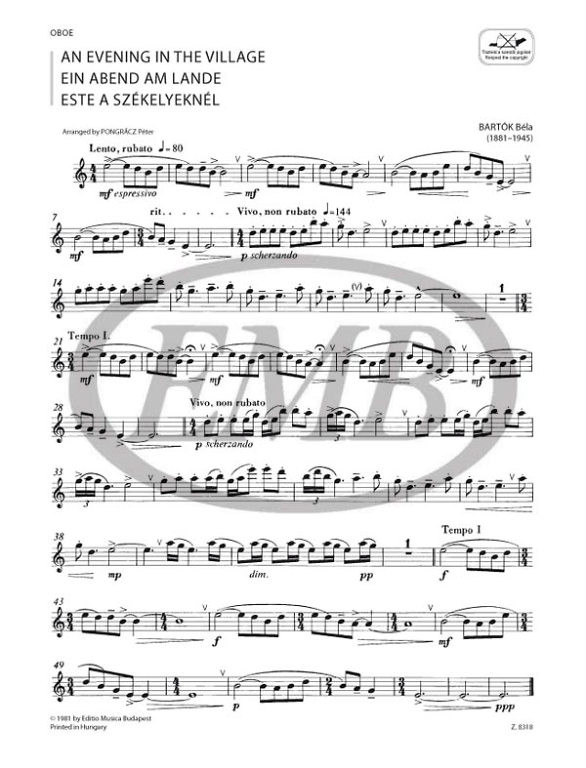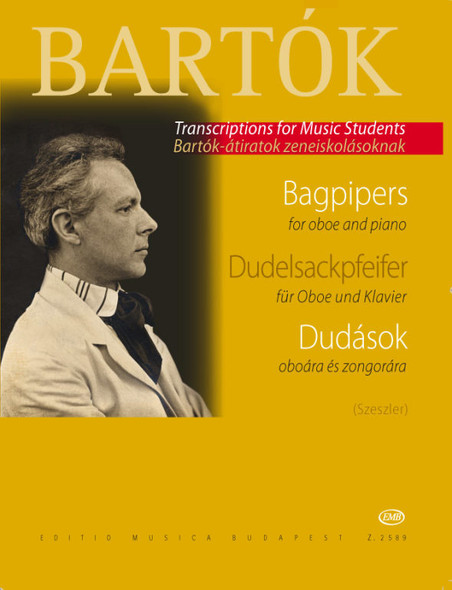Description
Bartók Béla: An Evening in the Village / for oboe and piano / Transcribed by Pongrácz Péter / Editio Musica Budapest Zeneműkiadó / 1981 / Bartók Béla: Este a székelyeknél / Átírta Pongrácz Péter
Paperback
Made in Hungary
Setting: Oboe and Piano
Series: Bartók Transcriptions for Music Students
Period: 20th Century
Language: Hungarian, English, German
Length: 6 pages
Format: Bach (23 x 30,2 cm)
Weight: 0.049 kg
Published: October 1981
Publisher: Editio Musica Budapest Zeneműkiadó
Item number: 8318
ISMN: 9790080083185 / 979-0080083185
Hangszer/letét: Oboa és zongora
Sorozat: Bartók-átiratok zeneiskolásoknak
Korszak: XX. század
Nyelv: magyar, angol, német
Terjedelem: 6 oldal
Formátum: Bach (23 x 30,2 cm)
Súly: 0,049 kg
Első megjelenés: 1981. október
Kiadó: Editio Musica Budapest Zeneműkiadó
Katalógusszám: 8318
An Evening in the Village was composed in 1908 as no. 5 of the Ten Easy Piano Pieces. It has become one of Bartók's favorite works, which the composer himself was fond of playing at recitals. As he explained in an American interview, it was ''an original composition that is ... with themes of my own invention but ... the themes are in the style of the Hungarian-Transylvanian folk tunes. There are two themes. The first one is a parlando-rubato-rhythm and the second one is more in a dance-like rhythm. The second one is more or less the imitation of a peasant flute playing.'' Bartók also orchestrated the piece in 1931 as no. 1 of Hungarian Sketches.
In 2015 we are launching a series entitled Bartók Transcriptions for Music Students to mark the 70th anniversary of the composer’s death. This involves reissuing our tried publications, and publishing some further, new transcriptions that fulfill in every respect the strict aesthetic demands of the earlier ones. We trust these publications will allow us to introduce still more music students to the realm of one of the great geniuses of 20th-century music.
A Tíz könnyű zongoradarab 5. számaként 1908-ban komponált Este a székelyeknél valódi Bartók-sláger, amelyet maga a zeneszerző is előszeretettel játszott hangversenyein. Egy amerikai interjúban úgy nyilatkozott róla, hogy ''... eredeti kompozíció, azaz témái sajátjaim, de ezek a témák az erdélyi magyar népdalok stílusát követik. Két témája közül az első parlando-rubato ritmusú, a másik inkább táncritmusú ” többé-kevésbé egy paraszti furulyázás imitációja.'' A darabot Bartók 1931-ben zenekarra is meghangszerelte, a Magyar képek 1. számaként.
2015-ben, a zeneszerző halálának 70. évfordulója alkalmából Bartók-átiratok zeneiskolásoknak címmel sorozatot indítunk. Ennek keretében nemcsak a korábbi, már bevált kiadványainkat tesszük újból hozzáférhetővé, hanem olyan új átiratokat is megjelentetünk, amelyek mindenben megfelelnek a régebbiekkel szemben támasztott szigorú esztétikai követelményeknek. Bízunk benne, hogy kiadványaink révén még több zenét tanulót avathatunk be a 20. század egyik legnagyobb zenei géniuszának világába.























